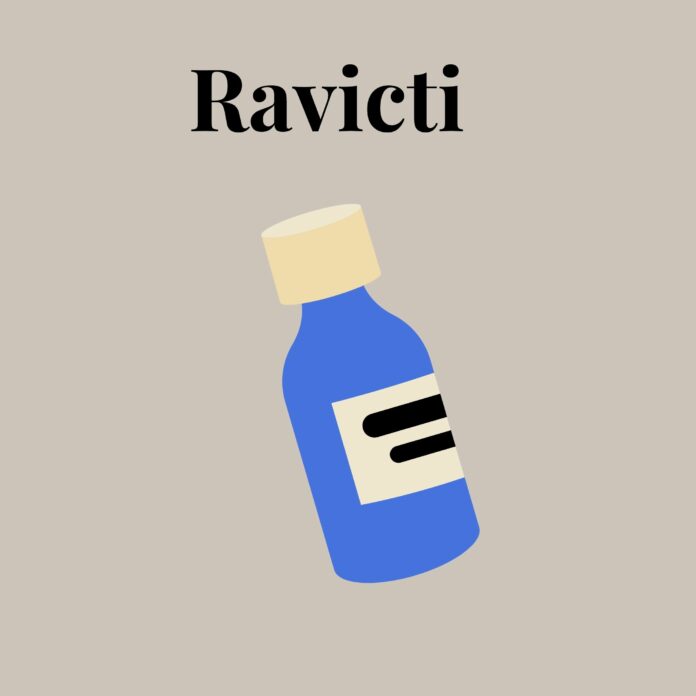Uses
RAVICTI is a prescription medicine used in adults and in children 2 months of age and older for long-term management of high blood levels of ammonia (hyperammonemia) caused by a condition called a urea cycle disorder (UCD). RAVICTI should be used if the UCD cannot be managed with a low protein diet and dietary supplements alone. RAVICTI must be used along with a low protein diet and in some cases dietary supplements.
- RAVICTI is not used for the acute treatment of hyperammonemia in people with UCD.
- It is not known if it is safe and effective for the treatment of N-acetylglutamate synthase (NAGS) deficiency
Side Effects Of Ravicti
The most common side effects in adults include:
- diarrhea
- gas
- headache
- abdomen (stomach) pain
- vomiting
- tiredness
- decreased appetite
- indigestion or heartburn
The most common side effects of RAVICTI in children 2 years to 17 years of age include:
The most common side effects of RAVICTI in children 2 months to less than 2 years of age include:
- low white blood cell count (neutropenia)
- vomiting
- diarrhea
- fever
- reduced food intake
- cough
- stuffy nose
- runny nose
- skin rash
- small round bumps on the skin
Tell your doctor if you have any side effect that bothers you or that does not go away. These are not all of the possible side effects of RAVICTI.
Warnings & Precautions
Children less than 2 months of age should not take RAVICTI because it may not be digested in children less than 2 months of age.
• Do not take RAVICTI if you are allergic to phenylbutyrate. Call your doctor or go to the nearest hospital emergency room if you have wheezing, shortness of breath, cough, low blood pressure, flushing, nausea, or a rash while taking RAVICTI.
Before taking RAVICTI, tell your doctor about any medical conditions and if you:
- Have liver or kidney problems.
- Have pancreas or bowel (intestine) problems.
- Are pregnant or plan to become pregnant. It is not known if RAVICTI will harm your unborn baby.
- Pregnancy Registry: There is a Pregnancy Registry for women who take RAVICTI just before becoming pregnant or who become pregnant during treatment with it. The purpose of this registry is to collect information about the health of you and your baby. Talk to your doctor about how you can join the Pregnancy Registry. For more information about this registry,
- Are breastfeeding or plan to breastfeed. It is not known if it passes into your breast milk. Breastfeeding is not recommended during treatment with RAVICTI. Talk to your doctor about the best way to feed your baby if you take it.
Tell your doctor about all the medicines you take, including prescription and over-the-counter medicines, vitamins, dietary and herbal supplements. Know the medicines you take. Keep a list of them to show your doctor and pharmacist when you get a new medicine.
Dosage Of Ravicti
Take RAVICTI exactly as your doctor tells you.
- Your doctor will tell you how much RAVICTI to take and when to take it.
- Your doctor may change your dose if needed.
- Take RAVICTI with food or formula.
- RAVICTI is an oral liquid that is taken by mouth using an oral syringe or dosing cup. Ask your pharmacist for an oral syringe or dosing cup if you do not have one.
- If you have a nasogastric or gastrostomy tube in place and can swallow, you should take RAVICTI by mouth.
- Stay on the diet that your doctor gives you.
- If you take too much RAVICTI, hospital emergency room right away.
For people who cannot swallow and who have a nasogastric or gastrostomy tube in place, RAVICTI should be given as follows:
- Use an oral syringe to withdraw the prescribed dose from the bottle.
- Place the tip of the syringe into the nasogastric or gastrostomy tube and push the plunger of the syringe to give RAVICTI into the tube.
- Add 10 mL of water or formula to the syringe and push the plunger of the syringe to flush any remaining medicine from the nasogastric or gastrostomy tube into the stomach.
- If needed, flush the nasogastric or gastrostomy tube again with 10 mL of water or formula to clear the nasogastric or gastrostomy tube.
Other
Medicines are sometimes prescribed for purposes other than those listed in a Medication Guide. Do not use RAVICTI for a condition for which it was not prescribed. Do not give it to other people, even if they have the same symptoms you have. It may harm them. You can ask your doctor or pharmacist for information about RAVICTI that is written for health professionals.
Source
All information has been provided courtesy of MedLinePlus from the National Library of Medicine and from the FDA.



